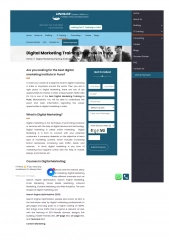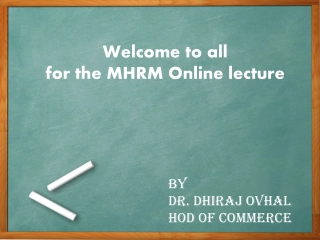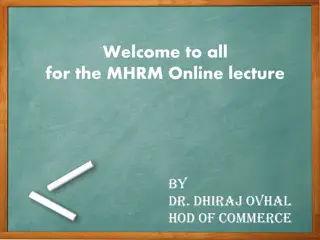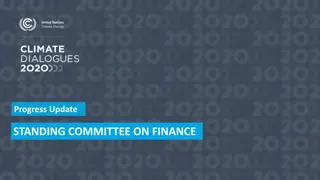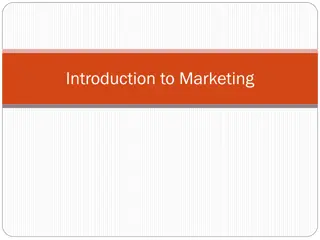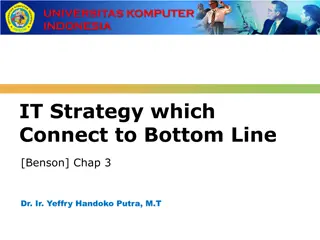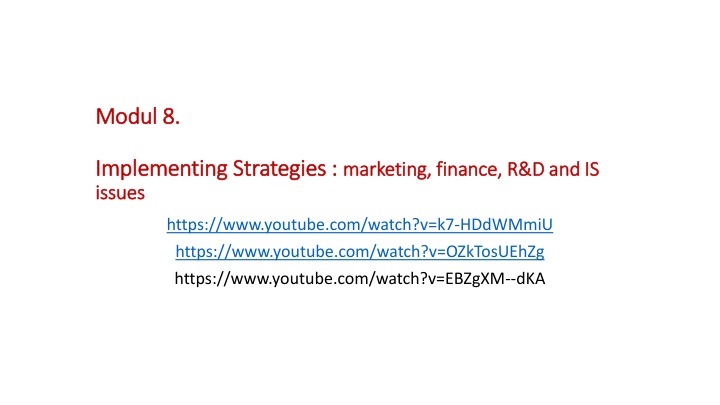
Implementing Strategies in Marketing, Finance, R&D, and IS
Explore the key issues in implementing strategies in marketing, finance, research & development, and information systems. Learn about market segmentation, alternative bases for segmenting markets, and the variables of the marketing mix. Discover insights on decision-making in areas such as distribution, advertising, promotion, pricing, and more.
Download Presentation

Please find below an Image/Link to download the presentation.
The content on the website is provided AS IS for your information and personal use only. It may not be sold, licensed, or shared on other websites without obtaining consent from the author. If you encounter any issues during the download, it is possible that the publisher has removed the file from their server.
You are allowed to download the files provided on this website for personal or commercial use, subject to the condition that they are used lawfully. All files are the property of their respective owners.
The content on the website is provided AS IS for your information and personal use only. It may not be sold, licensed, or shared on other websites without obtaining consent from the author.
E N D
Presentation Transcript
Modul 8. Modul 8. Implementing Implementing S Strategies issues issues trategies : : marketing, finance, R&D and IS marketing, finance, R&D and IS https://www.youtube.com/watch?v=k7-HDdWMmiU https://www.youtube.com/watch?v=OZkTosUEhZg https://www.youtube.com/watch?v=EBZgXM--dKA
Apa yang harus ditambah Apa yang harus dikurangi Apa yang harus dimulai Apa yang harus dihentikan
Marketing Issues 1. To use exclusive dealership or multiple channel of distribution 2. To use heavy, light or no TV 5. To offer a complete or limited warranty 6. To reward salesperson based on straight salary, straight commission, or combination 7. To advertise online or not advertising 3. To limit (or not) the share of business done with a single customer 4. To be a price leader or price follower
Market Segmentation Market segmentation can be defined as the subdividing of market into distinct subset of customer according to need and buying habits Market segmentation is an important variable in strategy implementation for at least three major reason : Strategies such as market development, product development new or improved market segmentation are required Market segmentation allow a firm to operate with limited resource because mass production, mass marketing and mass advertising are not required Marketing segmentation decision impact to marketing mix variable 4P
Alternative Bases for Market Segmentation Geographic Demographic Psychographic Behavioral Region Province City size Density Climate Age Gender Family size Family life cycle Income Occupation Education Religion Race Nationality Social class Personality Use occasion Benefit sought User status Usage rate Loyalty status Readiness stage Attitude toward product
The Marketing Mix Variables Product Place Promotion Price Quality Features & option Style Brand Name Packaging Product line Warranty Service level Other services Distribution Channel Distribution Coverage Outlet Location Sales territories Inventory level and location Transportation carriers Advertising Personal selling Sales promotion Publicity Level Discounts and allowances Payment term
Product Positioning After markets has been segmented, we can target particular customer groups, the next step is to find out what customer need and want. Product positioning is used for deciding how to meet the needs and wants of particular customers groups. The following steps are required in product positioning : Select key criteria that effectively differentiate products or service in the industry. Diagram a two-dimensional product-positioning with specified criteria on axis Plot major competitor s product or service in the resultant four-quadrant matrix Identify area in the positioning map, look for vacant areas (niche) Develop a marketing plan to position the company s product or service appropriately.
Product Positioning Maps Personal High Convenience Bank B Firm 1 Firm 2 Bank A High Cust Loyalty Bank C Aggressive Low Cust Loyalty Conservative Bank D Firm 3 Bank E Impersonal Low Convenience Rental Car BANKS
Product Positioning Maps as a Tool Look for the hole or vacant niche. The best strategic opportunity may be an un- served segment Don t squat between segment. Any advantage from squatting (such as larger target market) is offset by a failure to satisfy one segment Some rules for using product positioning as a strategy implementation tool Don t serve two segment with the same strategy. Usually strategy successful with one segment can not be directly transferred to another segment Don t position yourself in the middle of the map. The middle usually means a strategy that is not clearly perceived to have any distinguishing characteristic
Finance / Accounting Issues 1.To raise capital with short-term debt, long-term debt, prefer stock, or common stock. 2.To lease or buy fixed assets 3.To determine an appropriate dividend payout ratio 4.To use LIFO (last in first out), FIFO (first in first out), or a market value accounting approach 5.To extend the time of account receivable 6.To establish a certain percentage discount on account within a specified period of time 7.To determine the amount of cash that should be kept on hand
Acquiring Capital to Implement Strategy The basic source of additional of capital for an organization are debt and equity. An Earning Per Share / Earning Before Interest and Taxes (EPS/EBIT) analysis is the most widely used technique for determining whether debt, stock or combination of debt and stock is the best alternative for rising capital to implement strategies.
Case : Brown Company They need to rise $ 1 million to finance implementation of a market- development strategy The company s common stock currently sells $ 50 per share, and 100,000 shares are outstanding. The prime interest rate is 10%, and the company tax rates is 50%. The company s EBIT next year are expected to be $ 2 million if recession occurs, $ 4 million if the economy stay as is, $ 8 million if economy significantly improve.
EPS/EBIT Analysis (in million) Common Stock Financing Debt Financing Combination Financing Boom Boom Boom Normal Normal Normal Recession Recession Recession EBIT $ 2.0 $ 4.0 $ 8.0 $ 2.0 $ 4.0 $ 8.0 $ 2.0 $ 4.0 $ 8.0 $ 0 $ 0 $ 0 $ 0.10 $ 0.10 $ 0.10 $ 0.05 $ 0.05 $ 0.05 Interest EBT $ 2.0 $ 4.0 $ 8.0 $ 1.90 $ 3.90 $ 7.90 $ 1.95 $ 3.95 $ 7.95 Taxes $ 1.0 $ 2.0 $ 4.0 $ 0.95 $ 1.95 $ 3.95 $.975 1.975 3.975 EAT 1.0 2.0 4.0 0.95 1.95 $ 3,95 0.975 1.975 3.975 #Shares 0.12 0.12 0.12 0.10 0.10 0.10 0.11 0.11 0.11 EPS ($) 8.33 16.66 33.33 9.5 19.50 39.50 8.86 17.95 36.14 Debt is the best financing alternative.
Projected Financial Statement Projected financial statement analysis is a central strategy implementation technique because it allow to examine the expected result of various action and approach. A projected income statement and balance sheet to compute projected financial ratio under various strategy implementation. Result of the Enron collapse and accounting scandal and the ensuing US Sarbanes-Oxley Act (SOA) being much more diligent in preparing projected financial statement.
Projected Income Statement (in million) Projected Income Statement Year 2007 Projected 2008 Remarks Sales $ 100 $ 150 50% increase Cost of good sold 70 105 70% of sales Gross Margin 30 45 Selling Expense 10 15 10% of sales Administrative Expense 5 7.5 5% of sales EBIT 15 22.5 Interest 3 3 Earning Before Tax 12 19.5 Taxes 6 9.75 50% rates Net Income 6 9.75 Dividends 2 5 Retain Earning 4 4.75
Projected Balance Sheet Projected Balance Sheet Year 2007 Projected 2008 Remarks Assets Current Assets 27 56.75 Fixed Assets 55 75 Total Assets 82 131.75 Liabilities Current Liabilities 20 20 Long-term Debt 40 70 Borrowed $ 30 million Additional Paid-in-capital 20 35 Issued 100,000 shares at $ 150 each Retained Earning 2 6.75 $ 2 + $ 4.75 Total Liabilities & Net Worth 82 131.75
Financial Budget Financial budget is a document that detail how funds will be obtained and spent for a specified period of time. Financial budgeting is a method for specifying what must be done to complete strategy implementation successfully. Common type of budgets include cash budget, operating budget, sales budgets, profit budgets, factory budgets, expense budget, divisional budgets, variable budgets, flexible budgets, and fixed budgets Budget have some limitations : Over budgeting or under budgeting caused a problem Budgets can become substitute of objective Budget can hide inefficiency Budget are sometimes used as instruments of tyranny that result in frustration, resentment, absenteeism, and high turn over.
Research and Development (R&D) R&D policies can enhance strategy implementation effort to : Emphasis product or process improvement Stress basic or applied research Be leaders or followers in R&D Develop robotic or manual type process Spend a high, average, or low amount of money in R&D Perform R&D within the firm or to contract R&D to outside firm Use university researcher or private sector researcher R & D person are generally charged with developing new product and improving old product in a way that will allow effective strategy implementation
R & D Activities Strategy being Implemented Type of Organization R&D Activities Test the effect of a new drug on different subgroup. Pharmaceutical Product Development Test the performance of various keel design under various condition. Boat Manufacturing Related Diversification Plastic Container Manufacturer Market Penetration Develop biodegradable container Develop a telecommunication system in a foreign country. Electronic Company Market Development
Management Information System (MIS) Issues MIS will not be an option in the future, but it will be a requirement Information collection, retrieval and storage can be used to create competitive advantage in ways such as cross-selling to customer, monitoring supplier, managing funds etc In many firm, information technology is doing away the workplace and allowing employee to work at home or anywhere A good information system can allow a firm to reduce cost
Tugas M10 1. Pelajari Case sesuai dengan kelompok anda. 2. Identifikasi : marketing issues Financial / accounting issues R & D issues MIS issues a. b. c. d.
Quiz Sebuah perusahaan dibidang Telekomunikasi terkemuka dan sudah go public sedang mengimplementasikan Strategi Market Development mebutuhkan dana sebesar Rp 100 Milyard untuk mendapatkan dana tersebut terdapat 3 alternatif : Common Stock (menjual saham), Debt (pinjaman dari Bank) atau Combination ( 50% common stock dan 50% debt). Situasi Perusahaan saat ini sbb : Jumlah saham beredar : 100 juta lembar, Harga per lembar saham : Rp 20.000,- Bunga pinjaman per tahun : 25% Pajak perusahaan sebesar 30% Perusahaan memproyeksikan EBIT tahun depan sebesar Rp 300 Milyard Pertanyaan : Dengan menggunakan tool EPS / EBIT Analysis ( R David page 294) alternative mana yang paling menguntungkan bagi perusahaan untuk mendapatkan dana tersebut



